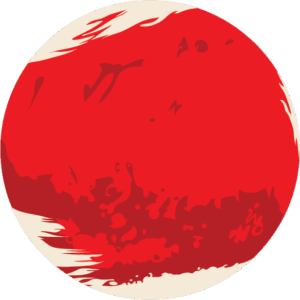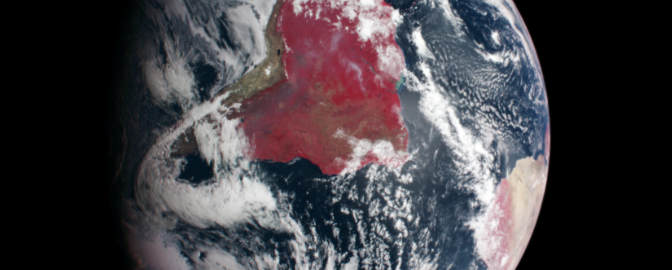The Downlink • Jul 25, 2025
Worlds in swirls
Space Snapshot

This image may be a first in our exploration of the Cosmos: a direct view of a planet forming around a star. Astronomers using the European Southern Observatory’s Very Large Telescope in Chile captured this image of the young star HD 135344B, which is 440 light-years away. The star’s light is blocked out by the dark circle in the center of the image. To its right, you can see a circled bright spot in the spirals of material that surround the star. This appears to be a giant planet just beginning to form. If confirmed, this would be the first direct observation of a planet in the process of formation. Image credit: ESO/F. Maio et al.
Fact Worth Sharing

Recent research has suggested that planets can start forming just a few hundred thousand years after their host star begins to form — extremely fast on cosmic timescales.
Mission Briefings


Hubble has spotted the interstellar Comet 3I/ATLAS for the first time. On July 21, the Hubble Space Telescope captured its first images of interstellar comet 3I/ATLAS (pictured). The comet’s trajectory suggests it may come from a region of the Milky Way older than our Solar System, potentially making this the oldest comet ever observed. Image credit: NASA/ESA/Hubble.

A newly discovered object could make Planet 9 less likely. Astronomers have found a trans-Neptunian object with an unusual orbit that makes the existence of a distant ninth planet less likely. The researchers suggest that if Planet 9 does exist, it would have to be much farther away than previously thought, or already ejected from the Solar System.

Makenzie Lystrup, PhD, is stepping down as director of NASA’s Goddard Space Flight Center. Lystrup was the first female director of Goddard and has held the position since April 2023. She is the second NASA center director to leave in two months.

JWST finds signs of recent activity beneath Europa’s icy shell. Chaotic terrain on Jupiter’s moon Europa appears to contain sodium chloride, carbon dioxide, and hydrogen peroxide — compounds that degrade quickly under radiation, meaning that they were likely recently churned up by geological activity. NASA’s Europa Clipper mission is currently en route to the moon, where it will further explore its potential habitability.
From The Planetary Society


Why send people back to the Moon? With higher costs and greater risk, crewed missions are inherently more difficult than robotic ones. But The Planetary Society’s science editor, Asa Stahl, PhD, explains why astronauts can be better than robots at conducting the kind of science that we want to do on the Moon. Pictured: Apollo 15 Commander David Scott deploying experiments on the Moon in 1971. Image credit: NASA.

Catch up on Planetary Radio. On our weekly show, New Horizons Principal Investigator Alan Stern celebrates the 10th anniversary of the mission’s flyby with Pluto, with updates from planetary scientist Adeene Denton and Planetary Society Director of Government Relations Jack Kiraly. And on the first episode of Planetary Radio: Book Club Edition, bestselling science fiction author Andy Weir joins us for a conversation about his #1 bestselling novel, “Project Hail Mary,” soon to be a major motion picture.

Catch Sarah Al-Ahmed on some other great shows. Planetary Radio’s host and producer recently shared her love and knowledge of space with new audiences. Sarah joined streamer Moohoodles on Twitch last week, raising over $1,000 for The Planetary Society while discussing New Horizons, Pluto, and the importance of advocacy. She also joined Griffith Observatory’s All Space Considered show to talk about the Vera C. Rubin Observatory and the discoveries it’s already making about our Universe.

You can be Earth's first line of defense. Dangerous asteroid impacts are rare, but they do happen. And they will continue to happen unless we can prevent them. That’s where you come in! You can help advance the search for these near-Earth objects with a gift of any amount. Plus, when you give today, a generous Society member will match your gift dollar for dollar, up to a total of $25,000.
Space Advocate Update


The Senate advanced legislation that would fully fund NASA and space science. On July 17, the Senate Appropriations Committee voted to approve its version of NASA's 2026 funding legislation, which provides $24.9 billion for NASA and $7.3 billion for NASA science — both the same as in 2025. This is a critical first step: it represents a complete rejection of the White House's proposal for draconian cuts to NASA science. But it’s only a first step. The House and Senate funding bills must now be reconciled, voted on by their full chambers, and signed by the President. We don’t know when this will happen, and likely won’t know until later this year. In the meantime, we will not relent on our advocacy work.

Politicians and scientists are calling on the NASA administrator to halt cuts to the agency. A total of 63 Members of Congress from both parties signed a letter to acting NASA Administrator Sean Duffy this week, urging him to cease implementation of President Trump’s proposed cuts to NASA. And in a separate letter to Duffy, nearly 300 current and former NASA employees expressed formal dissent to the unprecedented, unstrategic, and wasteful cuts to the agency.
What's Up

This week, look for super bright Venus close to the constellation Orion in the predawn east, with very bright Jupiter nearby. Soon after sunset, Mercury is low in the west. Look for reddish Mars shining in the evening west, joined by the Moon on July 28. Yellowish Saturn rises in the middle of the night and stays up until dawn. Find out what else to look for in July’s night skies.
Carl Sagan. Bill Nye. You.

The Planetary Society was co-founded by Carl Sagan to give you an essential role in space exploration. Not already a member? Join today! When you become a member, you join a global community of space advocates who make a critical difference in supporting a future full of space exploration. Join CEO Bill Nye and become part of the world's most effective independent space advocacy nonprofit!
Wow of the Week

Your bathtub drain might be hiding the secrets of planet formation. Scientists at the Max Planck Institute for Astronomy in Germany recently recreated how planets form by swirling dust in a tiny water vortex, creating the same kind of “water tornado” you’ve likely observed in an emptying tub. The researchers discovered that this mini whirlpool mimicked the way gas and dust behave in real planet-forming disks, with the particles inside even following the same physics that govern orbiting planets in space. Image credit: S. Schütt (University of Greifswald).
Send us your artwork!
We love to feature space artwork in the Downlink. If you create any kind of space-related art, we invite you to send it to us by replying to any Downlink email or writing to [email protected]. Please let us know in your email if you’re a Planetary Society member!


 Explore Worlds
Explore Worlds Find Life
Find Life Defend Earth
Defend Earth

